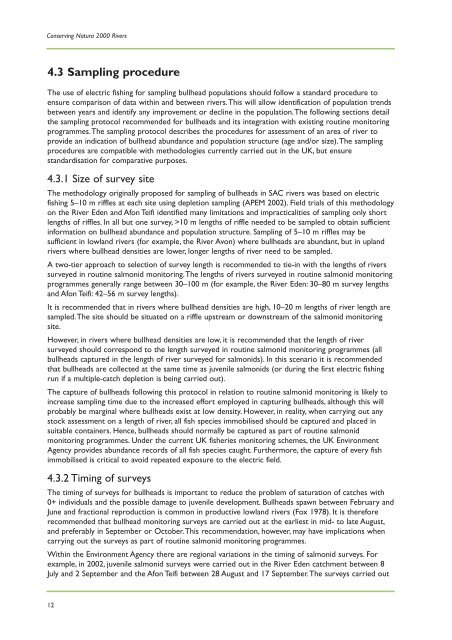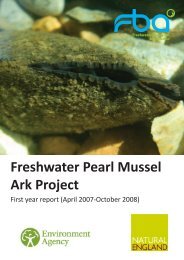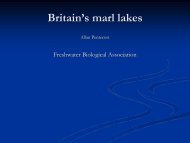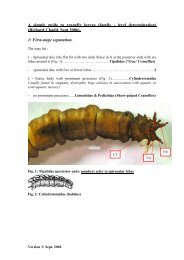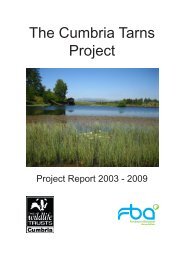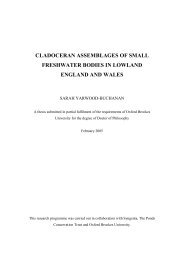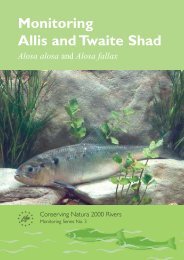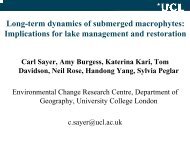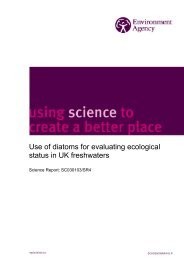Monitoring the Bullhead - European Commission
Monitoring the Bullhead - European Commission
Monitoring the Bullhead - European Commission
Create successful ePaper yourself
Turn your PDF publications into a flip-book with our unique Google optimized e-Paper software.
Conserving Natura 2000 Rivers<br />
4.3 Sampling procedure<br />
The use of electric fishing for sampling bullhead populations should follow a standard procedure to<br />
ensure comparison of data within and between rivers.This will allow identification of population trends<br />
between years and identify any improvement or decline in <strong>the</strong> population.The following sections detail<br />
<strong>the</strong> sampling protocol recommended for bullheads and its integration with existing routine monitoring<br />
programmes.The sampling protocol describes <strong>the</strong> procedures for assessment of an area of river to<br />
provide an indication of bullhead abundance and population structure (age and/or size).The sampling<br />
procedures are compatible with methodologies currently carried out in <strong>the</strong> UK, but ensure<br />
standardisation for comparative purposes.<br />
4.3.1 Size of survey site<br />
The methodology originally proposed for sampling of bullheads in SAC rivers was based on electric<br />
fishing 5–10 m riffles at each site using depletion sampling (APEM 2002). Field trials of this methodology<br />
on <strong>the</strong> River Eden and Afon Teifi identified many limitations and impracticalities of sampling only short<br />
lengths of riffles. In all but one survey, >10 m lengths of riffle needed to be sampled to obtain sufficient<br />
information on bullhead abundance and population structure. Sampling of 5–10 m riffles may be<br />
sufficient in lowland rivers (for example, <strong>the</strong> River Avon) where bullheads are abundant, but in upland<br />
rivers where bullhead densities are lower, longer lengths of river need to be sampled.<br />
A two-tier approach to selection of survey length is recommended to tie-in with <strong>the</strong> lengths of rivers<br />
surveyed in routine salmonid monitoring.The lengths of rivers surveyed in routine salmonid monitoring<br />
programmes generally range between 30–100 m (for example, <strong>the</strong> River Eden: 30–80 m survey lengths<br />
and Afon Teifi: 42–56 m survey lengths).<br />
It is recommended that in rivers where bullhead densities are high, 10–20 m lengths of river length are<br />
sampled.The site should be situated on a riffle upstream or downstream of <strong>the</strong> salmonid monitoring<br />
site.<br />
However, in rivers where bullhead densities are low, it is recommended that <strong>the</strong> length of river<br />
surveyed should correspond to <strong>the</strong> length surveyed in routine salmonid monitoring programmes (all<br />
bullheads captured in <strong>the</strong> length of river surveyed for salmonids). In this scenario it is recommended<br />
that bullheads are collected at <strong>the</strong> same time as juvenile salmonids (or during <strong>the</strong> first electric fishing<br />
run if a multiple-catch depletion is being carried out).<br />
The capture of bullheads following this protocol in relation to routine salmonid monitoring is likely to<br />
increase sampling time due to <strong>the</strong> increased effort employed in capturing bullheads, although this will<br />
probably be marginal where bullheads exist at low density. However, in reality, when carrying out any<br />
stock assessment on a length of river, all fish species immobilised should be captured and placed in<br />
suitable containers. Hence, bullheads should normally be captured as part of routine salmonid<br />
monitoring programmes. Under <strong>the</strong> current UK fisheries monitoring schemes, <strong>the</strong> UK Environment<br />
Agency provides abundance records of all fish species caught. Fur<strong>the</strong>rmore, <strong>the</strong> capture of every fish<br />
immobilised is critical to avoid repeated exposure to <strong>the</strong> electric field.<br />
4.3.2 Timing of surveys<br />
The timing of surveys for bullheads is important to reduce <strong>the</strong> problem of saturation of catches with<br />
0+ individuals and <strong>the</strong> possible damage to juvenile development. <strong>Bullhead</strong>s spawn between February and<br />
June and fractional reproduction is common in productive lowland rivers (Fox 1978). It is <strong>the</strong>refore<br />
recommended that bullhead monitoring surveys are carried out at <strong>the</strong> earliest in mid- to late August,<br />
and preferably in September or October.This recommendation, however, may have implications when<br />
carrying out <strong>the</strong> surveys as part of routine salmonid monitoring programmes.<br />
Within <strong>the</strong> Environment Agency <strong>the</strong>re are regional variations in <strong>the</strong> timing of salmonid surveys. For<br />
example, in 2002, juvenile salmonid surveys were carried out in <strong>the</strong> River Eden catchment between 8<br />
July and 2 September and <strong>the</strong> Afon Teifi between 28 August and 17 September.The surveys carried out<br />
12


